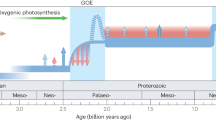Abstract
Cyanophytes range from at least 2,200 Myr (ref. 1) to the Recent, but they only produced common marine shelly fossils during the Palaeozoic and Mesozoic (570–80 Myr) (Fig. 1). This contrasts with the pattern of metazoan evolution in which rapid diversification near the Precambrian–Cambrian boundary was closely accompanied by skeletonization2 which has been retained in marine environments to the Recent. Attempts to explain this unusual geological distribution of marine calcareous cyanophytes cannot be made solely by reference to biological processes because these algae are mainly dependent on environmental conditions for their calcification3. Thus, the presence or absence of calcified cyanophytes may be a general indication of long-term changes in seawater chemistry. This likelihood has been recognized previously4 but has not been explored in any detail. Here I outline some possible explanations and suggest that cyanophyte calcification was facilitated by enhancement of marine CaCO3 precipitation rates in the late Precam-brian because of decrease in the Mg2+/Ca2+ ratio, linked to falling levels and extensive dolomite formation. Scarcity of calcareous cyanophytes in Cenozoic marine environments again implicates the Mg2+/Ca2+ ratio, inferred from oöid mineralogy to have increased in the late Mesozoic5, as a factor influencing cyanophyte calcification in the sea.
This is a preview of subscription content, access via your institution
Access options
Subscribe to this journal
Receive 51 print issues and online access
$199.00 per year
only $3.90 per issue
Buy this article
- Purchase on Springer Link
- Instant access to full article PDF
Prices may be subject to local taxes which are calculated during checkout
Similar content being viewed by others
References
Cloud, P. Paleobiology 2, 351–387 (1976).
Stanley, S. M. Am. J. Sci. 276, 56–76 (1976).
Golubic, S. in The Biology of Blue-Green Algae (eds Carr, N. G. & Whitton, B. A.) 434–473 (Blackwell, Oxford, 1973).
Monty, C. L. V. Ann. Soc. geol. Belg. 96, 585–624 (1973).
Sandberg, P. A. Sedimentology 22, 497–538 (1975).
Riding, R. & Voronova, L. G. Naturwissenschaften (in the press).
Wray, J. L. Developments in Palaeontology and Stratigraphy Vol. 4 (Elsevier, Amsterdam, 1977).
Winland, H. D. & Matthews, R. K. J. sedim. Petrol. 44, 921–927 (1974).
Golubic, S. & Campbell, S. E. in Phanerozoic Stromatolites (ed. Monty, C.) 209–229 (Springer, Berlin, 1981).
Schopf, J. W. Scient. Am. 239, 85–102 (1978).
Gebelein, C. D. in Developments in Sedimentology Vol. 20 (ed. Walter, M. R.) 499–515 (Elsevier, Amsterdam, 1976).
Stanley, S. M. Paleobiology 2, 209–219 (1976).
Durov, S. A. Trudy novocherk. politekh. Inst. 98, (1960).
Garrels, R. M. & Christ, C. L. Solutions, Minerals and Equilibria (Harper & Row, New York, 1965).
Holland, H. D. Proc. natn. Acad. Sci. U.S.A. 53, 1173–1182 (1965).
Berkner, L. V. & Marshall, L. C. Discuss. Faraday Soc. 37, 122–141 (1964).
Pytkowicz, R. M. J. Geol. 73, 196–199 (1965).
Berner, R. A. Soc. Econ. Paleont. Miner. Spec. Publ. 20, 37–43 (1974).
Ronov, A. B. Geokhimiya 8, 715–743 (1964).
Tucker, M. E. Geology 10, 1, 7–12 (1982).
Author information
Authors and Affiliations
Rights and permissions
About this article
Cite this article
Riding, R. Cyanophyte calcification and changes in ocean chemistry. Nature 299, 814–815 (1982). https://doi.org/10.1038/299814a0
Received:
Accepted:
Issue Date:
DOI: https://doi.org/10.1038/299814a0
This article is cited by
-
Implications of microbial mat induced sedimentary structures (MISS) in carbonate rocks: An insight from Proterozoic Rohtas Limestone and Bhander Limestone, India
Journal of Earth System Science (2020)
-
Cyanobacterial exopolymer properties differentiate microbial carbonate fabrics
Scientific Reports (2017)
-
Microbial carbonates in Holocene beachrocks, Shuiweiling, Luhuitou Peninsula, Hainan Island
Science in China Series D: Earth Sciences (2008)
-
Bacterial diversity and carbonate precipitation in the giant microbialites from the highly alkaline Lake Van, Turkey
Extremophiles (2005)
-
Lacustrine bioherms, spring mounds, and marginal carbonates of the Ries-impact-crater (Miocene, Southern Germany)
Facies (1995)
Comments
By submitting a comment you agree to abide by our Terms and Community Guidelines. If you find something abusive or that does not comply with our terms or guidelines please flag it as inappropriate.



